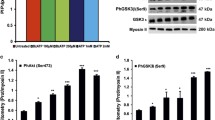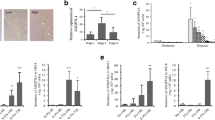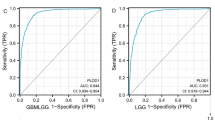Abstract
Apo2L/TRAIL-based therapy is a promising experimental approach to the treatment of human malignant gliomas. Osteoprotegerin (OPG) is a soluble decoy receptor for Apo2L/TRAIL that antagonizes Apo2L/TRAIL-induced apoptosis. High levels of OPG expressed by tumor cells might therefore abrogate the activity of exogenously added or adenovirally expessed Apo2L/TRAIL. Here we assessed the expression of OPG in human gliomas in vivo, in primary glioma cell cultures and in established glioma cell lines. Immunohistochemistry revealed weak OPG immunoreactivity in up to 5% of the tumor cells in 8 of 13 glioblastomas. Strong OPG labeling was detected in single scattered tumor cells in one of these specimens. Five glioblastomas did not express OPG. High OPG expression was found in 1 of 6 primary glioma cell cultures and in 1 of 12 established glioma cell lines, T98G. OPG released by T98G cells was biologically active in that it inhibited Apo2L/TRAIL-induced apoptosis in sensitive glioma cells. Altogether, however, these data suggest that OPG expression may not be a major pathway of glioma cell resistance to future Apo2L/TRAIL-based therapeutic approaches.



Similar content being viewed by others
References
Ashkenazi A, Pai RC, Fong S, Leung S, Lawrence DA, Marsters SA, Blackie C, Chang L, McMurtrey AE, Hebert A, DeForge L, Koumenis IL, Lewis D, Harris L, Bussiere J, Koeppen H, Shahrokh Z, Schwall RH (1999) Safety and antitumor activity of recombinant soluble Apo2 ligand. J Clin Invest 104:155–162
Bucay N, Sarosi I, Dunstan CR, Morony S, Tarpley J, Capparelli C, Scully S, Tan HL, Xu W, Lacey DL, Boyle WJ, Simonet WS (1998) Osteoprotegerin-deficient mice develop early onset osteoporosis and arterial calcification. Genes Dev 12:1260–1268
Emery JG, McDonnell P, Burke MB, Deen KC, Lyn S, Silverman C, Dul E, Appelbaum ER, Eichman C, DiPrinzio R, Dodds RA, James IE, Rosenberg M, Lee JC, Young PR (1998) Osteopotegerin is a receptor for the cytotoxic ligand TRAIL. J Biol Chem 273:14363–14367
Fulda S, Wick W, Weller M, Debatin KM (2002) Smac agonists sensitize for Apo2L/TRAIL- or anticancer drug-induced apoptosis and induce regression of malignant glioma in vivo. Nat Med 8:808–815
Griffith TS, Anderson RD, Davidson BL, Williams RD, Ratliff TL (2000). Adenoviral-mediated transfer of the TNF-related apoptosis-inducing ligand/Apo2 ligand gene induces tumor cell apoptosis. J Immunol 165:2886–2894
Holen I, Croucher PI, Hamdy FC, Eaton CL (2002) Osteoprotegerin (OPG) is a survival factor for human prostate cancer cells. Cancer Res 62:1619–1623
Kostenuik PJ, Shalhoub V (2001) Osteoprotegerin: a physiological and pharmacological inhibitor of bone resorption. Curr Pharm Des 7:613–635
Min H, Morony S, Sarosi I, Dunstan CR, Capparelli C, Scully S, Van G, Kaufman S, Kostenuik PJ, Lacey DL, Boyle WJ, Simonet WS (2000) Osteoprotegerin reverses osteoporosis by inhibiting endosteal osteoclasts and prevents vascular calcification by blocking a process resembling osteoclastogenesis. J Exp Med 192:463–474
Nagane M, Narita Y, Mishima K, Levitzki A, Burgess AW, Cavenee WK, Huang HJ (2001) Human glioblastoma xenografts overexpressing a tumor-specific mutant epidermal growth factor receptor sensitized to cisplatin by the AG1478 tyrosine kinase inhibitor. J Neurosurg 95:472–479
Nakashima T, Wada T, Penninger JM (2003) RANKL and RANK as novel therapeutic targets for arthritis. Curr Opin Rheumatol 15:280–287
Naumann U, Kügler S., Wolburg, H, Wick W, Rascher G, Schulz JB, Conseiller E, Bähr M, Weller M (2001) Chimeric tumor suppressor 1 (CTS1), a p53-derived chimeric tumor suppressor gene, kills p53 mutant- and p53 wild-type glioma cells in synergy with irradiation and CD95 ligand. Cancer Res 61:5833–5842
Naumann U, Waltereit R, Schulz JB, Weller M (2003) Adenoviral (full length) Apo2L/TRAIL gene therapy is an ineffective treatment strategy for malignant glioma. J Neuro-Oncol 61:7–15
Pollack IF, Erff M, Ashkenazi A (2001) Direct stimulation of apoptotic signaling by soluble Apo2L/tumor necrosis factor-related apoptosis-inducing ligand leads to selective killing of glioma cells. Clin Cancer Res 7:1362–1369
Rieger J, Naumann U, Glaser T, Ashkenazi A, Weller M (1998) APO2 ligand: a novel lethal weapon against malignant glioma? FEBS Lett 427:124–128
Rieger J, Ohgaki H, Kleihues P, Weller M (1999) Human astrocytic brain tumors express APO2L/TRAIL. Acta Neuropathol 97:1–4
Rieger J, Wick W, Weller M (2003) Human malignant glioma cells express semaphorins and their receptors, neuropilins and plexins. Glia 42:379–389
Röhn TA, Wagenknecht B, Roth W, Naumann U, Gulbins E, Krammer PH, Walczak H, Weller M (2001) CCNU-dependent potentiation of TRAIL/Apo2L-induced apoptosis in human glioma cells is p53-independent but may involve enhanced cytochrome c release. Oncogene 20:4128–4137
Roth W, Isenmann S, Naumann U, Kügler S, Bähr M, Dichgans J, Ashkenazi A, Weller M (1999) Locoregional Apo2L/TRAIL eradicates intracranial human malignant glioma xenografts in athymic mice in the absence of neurotoxicity. Biochem Biophys Res Commun 265:479–483
Shipman CM, Croucher PI (2003) Osteoprotegerin is a soluble decoy receptor for tumor necrosis factor-related apoptosis-inducing ligand/Apo2 ligand and can fuction as a paracrine survival factor for human myeloma cells. Cancer Res 63:912–916
Simonet WS, Lacey DL, Dunstan CR, Kelley M, Chang MS, Luthy R, Nguyen HQ, Wooden S, Bennet L, Boone T, Shimamoto G, DeRose M, Elliott R, Colombero A, Tan HL, Trail G, Sullivan J, Davey E, Bucay N, Renshaw-Gregg L, Hughes TM, Hill D, Pattison W, Campbell P, Boyle WJ (1997) Osteoproegerin: a novel secreted proein in volved in regulation of bone density. Cell 89:309–319
Truneh A, Sharma S, Silverman C, Khandekar S, Reddy MP, Deen KC, McLaughlin MM, Srinivasula SM, Livi GP, Marshall LA, Alnemri ES, Williams WV, Doyle ML (2000) Temperature-sensitive differential affinity of TRAIL for its receptors. DR5 is the highest affinity receptor. J Biol Chem 275:23319–23325
Walczak H, Miller RE, Ariail K, Gliniak B, Griffith T S, Kubin M, Chin W, Jones J, Woodward A, Le T, Smith C, Smolak P, Goodwin RG, Rauch CT, Schuh JC, Lynch DH (1999) Tumoricidal activity of tumor necrosis factor-related apoptosis-inducing ligand in vivo. Nat Med 5:157–164
Weller M, Frei K, Groscurth P, Krammer PH, Yonekawa Y, Fontana A (1994) Anti-Fas/APO-1 antibody-mediated apoptosis of cultured human glioma cells. Induction and modulation of sensitivity by cytokines. J Clin Invest 94:954–964
Weller M, Winter S, Schmidt C, Esser P, Fontana A, Dichgans J, Groscurth P (1997) Topoisomerase I inhibitors for human malignant glioma. Differential modulation of p53, p21, bax and bcl-2 expression and of CD95-mediated apoptosis by camptothecin and ß-lapachone. Int J Cancer 73:707–714
Yasuda H, Shima N, Nakafgawa N, Mochizucki SI, Yano K, Fujise N, Sato Y, Goto M, Yamaguchi K, Kuriyama M, Kanno T, Murakami A, Tsuda E, Morinaga T, Higashio K (1998) Identity of osteoclastogenesis inhibitory factor (OCIF) and osteoprotegerin (OPG): a mechanism by which OPG/OCIF inhibits osteoclasogenesis in vitro. Endocrinology 39:1329–1337
Author information
Authors and Affiliations
Corresponding author
Rights and permissions
About this article
Cite this article
Naumann, U., Wick, W., Beschorner, R. et al. Expression and functional activity of osteoprotegerin in human malignant gliomas. Acta Neuropathol 107, 17–22 (2004). https://doi.org/10.1007/s00401-003-0772-4
Received:
Revised:
Accepted:
Published:
Issue Date:
DOI: https://doi.org/10.1007/s00401-003-0772-4




